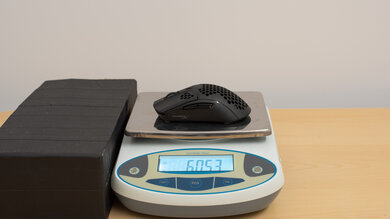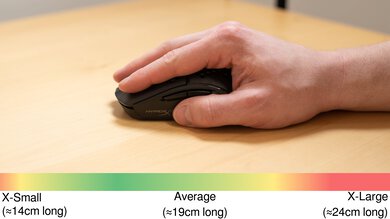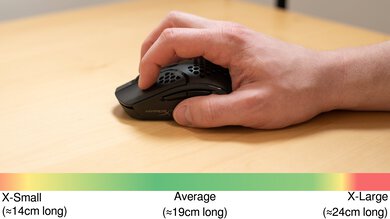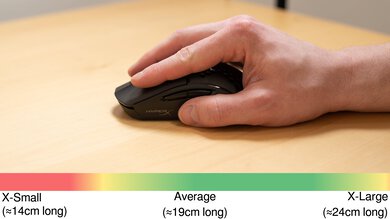The HyperX Pulsefire Haste Wireless is a mid-range lightweight gaming mouse and a wireless version of the popular HyperX Pulsefire Haste. It has a plastic body with honeycomb-shaped cutouts to reduce the overall weight, a dedicated CPI button behind the scroll wheel, and two side buttons on the left. It also shares the same symmetrical shape and sensor as the original wired version.
Our Verdict
The HyperX Pulsefire Haste Wireless is very good for office and multimedia work. It feels very well-built and has a comfortable symmetrical shape that's suitable for all hand sizes. You can connect this mouse with a USB receiver and program all of the buttons using the customization software. Unfortunately, there's no Bluetooth support, and the scroll wheel lacks L/R tilt buttons and a free-scrolling mode.
-
Feels very well-built.
-
Good portability.
-
Storage compartment for the USB receiver.
-
Connects wirelessly via USB receiver.
-
All buttons are programmable using the customization software.
-
No Bluetooth support.
-
Scroll wheel lacks L/R tilt buttons and a free-scrolling mode.
The HyperX Pulsefire Haste Wireless is a great FPS gaming mouse. It feels very well-built and has a symmetrical shape that's suitable for nearly all hand sizes using any grip type. It's also extremely lightweight and its feet glide very smoothly on mousepads and desks. Performance-wise, it has a broad CPI range and you can precisely set your preferred CPI by increments of 50. The click latency is also good, but it's higher than most mid-range FPS gaming mice, and you should look to other options if you're interested in fast-paced or competitive games.
-
Feels very well-built.
-
Extremely lightweight.
-
Comfortable symmetrical shape suitable for all hand sizes using nearly all grip types.
-
Good portability.
-
Storage compartment for the USB receiver.
-
Click latency is good for casual gaming, but too high for competitive play or fast-paced games.
-
CPI isn't as precisely adjustable as on many similar gaming mice.
The HyperX Pulsefire Haste Wireless is a decent mouse for MMO gaming, but it doesn't have nearly as many side buttons as a mouse designed specifically for MMO gaming. That said, you can customize all the buttons using the customization software. it also feels very well-built and its symmetrical shape is suitable for nearly all hand sizes and grip types. Performance-wise you can precisely set the CPI in a very broad range. The click latency is also good, although it's somewhat higher than most gaming mice in this price range.
-
Feels very well-built.
-
Comfortable symmetrical shape suitable for all hand sizes using nearly all grip types.
-
Good portability.
-
Storage compartment for the USB receiver.
-
Click latency is good for casual gaming, but too high for competitive play or fast-paced games.
-
Not nearly as many side buttons as a dedicated MMO gaming mouse.
-
Good portability.
-
Storage compartment for the USB receiver.
- 7.1 Work
- 8.2 Video Games (FPS)
- 7.2 Video Games (MMO)
- 8.4 Raw Performance
Changelog
- Updated Jan 10, 2024: We've updated the CPI graph displayed in the Sensor Latency section of this review. Our results remain the same, but these graphs have two new columns with results from the Delay At Half Movement and Delay To End Of Movement tests.
- Updated Dec 14, 2023: We've converted this review to Test Bench 1.5. This update adds a new Main Button test group, which provides button actuation data and switch information. We've also made minor changes to how we calculate the Office usage score. For more details, you can see our full changelog here.
- Updated Dec 09, 2022: We've converted this review to Test Bench 1.4. This update modifies our Hand Size Recommendation test, adding a more granular hand size recommendation chart. We've moved several minor tests into different test groups, removed the Travel usage, and added a new Raw Performance usage. For more details, you can see our full changelog here.
- Updated Nov 08, 2022: We've added a link to the newly-reviewed Glorious Model O PRO in the Style section of this review.
- Updated Sep 06, 2022: We've converted this review to Test Bench 1.3. This update adds a new Sensor Latency test and makes minor changes to several of our existing tests, resulting in test result changes in several sections. For more information, you can check out our full changelog here.
Check Price
Differences Between Sizes And Variants
The HyperX Pulsefire Haste Wireless we tested is the matte black color variant. There's also a white color variant available. You can see the label for our unit here.
Compared To Other Mice
The HyperX Pulsefire Haste Wireless is an ultra-lightweight gaming mouse and a wireless version of the popular HyperX Pulsefire Haste. It's also HyperX's first attempt at a wireless gaming mouse. While the original version is an entry-level model for those looking for an affordable ultra-lightweight option, this wireless version lands more squarely at a mid-range price point. Although, it retains the lower-end PixArt PAW3335 sensor as the previous version. There aren't many wireless gaming mice that compete with its weight around this price. However, it lacks the click latency performance of similar lightweight options like the GLORIOUS Model O Wireless.
For other recommendations, see our picks for the best wireless mice, the best gaming mice, and the best cheap gaming mice.
The Logitech G PRO X SUPERLIGHT and the HyperX Pulsefire Haste Wireless are both ultralight wireless gaming mice, but the Logitech performs better overall. The Logitech has mouse feet that glide more smoothly, a wider CPI range in which you can more precisely set your CPI, and significantly lower click latency. Its companion software is also compatible with Windows and macOS, while the HyperX software is only compatible with Windows.
The GLORIOUS Model O Wireless and The HyperX Pulsefire Haste Wireless are similar symmetrically-shaped gaming mice. The GLORIOUS has a slightly more flexible cable and allows you to adjust your CPI more precisely. It also has lower click latency. On the other hand, the HyperX is slightly lighter and better suited for a wider range of hand sizes and grip types.
The HyperX Pulsefire Haste 2 Wireless and the HyperX Pulsefire Haste Wireless are lightweight gaming mice in the same lineup. The Haste 2 Wireless is newer, and while it weighs virtually the same as its older counterpart, it has a solid plastic shell without visible honeycomb cutouts on its body. It also has better sensor performance and more durable left- and right-click switches. On the other hand, the original Pulsefire Haste Wireless is older and has honeycomb cutouts in its body.
The HyperX Pulsefire Haste 2 and the HyperX Pulsefire Haste Wireless are lightweight gaming mice in the same lineup. The Haste 2 is a wired model that's newer, lighter, and has a solid plastic shell. It also has lower click latency, significantly better sensor performance, and it supports a higher maximum polling rate of 8000Hz. On the other hand, the Haste Wireless is a heavier wireless model with honeycomb-shaped cutouts in its body.
The HyperX Pulsefire Haste Wireless is a wireless version of the HyperX Pulsefire Haste. The two mice are almost visually identical and share the same sensor. They're also the same weight. The standout difference between the two is that the newer Pulsefire Haste Wireless connects with a USB receiver. However, the original Pulsefire Haste has lower click latency.
The HyperX Pulsefire Haste Wireless and the Razer Viper Mini are both FPs gaming mice with symmetrical shapes. The HyperX connects wirelessly and has a wider CPI range and lower lift-off distance. On the other hand, the Razer is a wired-only model with much lower click latency.
The HyperX Pulsefire Haste Wireless and the GLORIOUS Model D are lightweight gaming mice. The HyperX is a wireless model with a symmetrical shape. It's also slightly lighter and feels a bit sturdier. Performance-wise, it has a somewhat wider CPI range and a lower minimum lift-off distance. On the other hand, the GLORIOUS is a wired model with lower click latency.
The HyperX Pulsefire Haste Wireless and the Razer Viper Ultimate are both symmetrically-shaped wireless gaming mice, but the Razer performs better in most respects. The Razer has a wider CPI range in which you can more precisely set your CPI and significantly lower click latency. It also has a pair of side buttons on either side, making it a true ambidextrous design, while the HyperX only has side buttons on the left. On the other hand, the HyperX is 15g lighter and feels somewhat sturdier.
Test Results
The HyperX Pulsefire Haste Wireless has a matte black plastic shell with honeycomb-shaped cutouts in the top and bottom. There's a HyperX logo on the left side towards the front and a single RGB zone in the scroll wheel. Visually, it looks identical to the original HyperX Pulsefire Haste. If you're interested in a mouse with a similar shape and size that has a solid plastic shell without honeycomb cutouts, check out the GLORIOUS Model O PRO.
The build quality of the HyperX Haste Wireless feels excellent. There's no noticeable rattle when shaking the mouse and only very minor squeaking when you forcibly squeeze it. HyperX also notes that this mouse is rated IP55 for protection against dust and liquids. This rating offers better protection than most gaming mice.
The HyperX Haste Wireless has a symmetrical shape that's comfortable whether you're right- or left-handed, although the side buttons are only on the left side. Its shape is also almost universally well-suited for all hand sizes using any grip type. However, if you have small hands, you may have trouble reaching some of the buttons using a fingertip grip.
HyperX advertises that this mouse has a battery life of up to 100 hours.
The HyperX Pulsefire Haste Wireless has a good quality paracord-like charging cable that glides well across desks. Unfortunately, it retains some kinks from its packaging.
You can program all buttons on the HyperX Haste Wireless. However, the scroll up and down inputs can't be re-programmed, and you can only switch the position of the left- and right-click buttons. The left- and right-click buttons use TTC Golden Micro switches, rated for 60 million clicks.
The HyperX Pulsefire Haste Wireless has good click latency, but it's higher than many other similarly-priced wireless gaming options. It isn't well suited for fast-paced or competitive games but more than sufficient for more casual gaming and everyday use. The latency was tested at a polling rate of 1000Hz.
The available polling rate options on the HyperX Pulsefire Haste Wireless are 125Hz, 250Hz, 500Hz, and 1000Hz. You can set up to five custom CPI settings per profile and switch between them using the dedicated CPI button behind the scroll wheel.
The HyperX Puslefire Haste Wireless uses HyperX's NGenuity software. It's easy to use but offers fewer customization options than software options from some other manufacturers, such as Razer Synapse or Logitech G Hub. For example, it lacks both an adjustable debounce and lift-off distance slider, and there's also only a single onboard profile that you can customize.
Comments
HyperX Pulsefire Haste Wireless: Main Discussion
Let us know why you want us to review the product here, or encourage others to vote for this product.
The full review has been posted here. Let us know what you think!
































